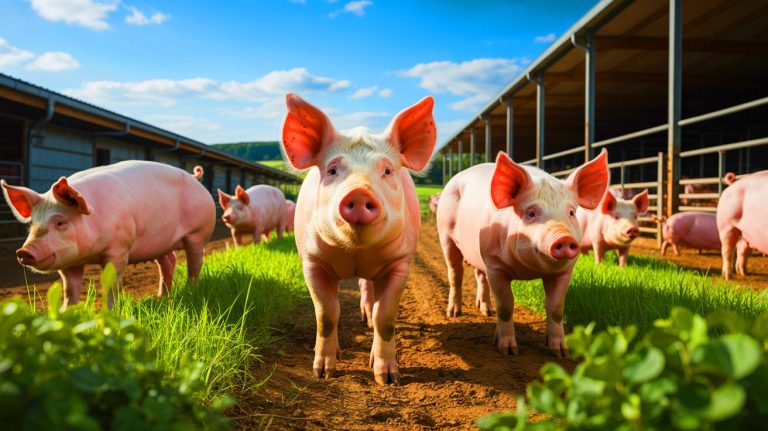| IN A NUTSHELL |
|
The US Food and Drug Administration’s recent approval of gene-edited pigs for human consumption marks a pivotal moment in agricultural biotechnology. This decision, centered around pigs developed by the UK-based company PIC, promises to revolutionize the pork industry by addressing the longstanding issue of Porcine Reproductive and Respiratory Syndrome (PRRS). This disease has been a significant challenge for farmers, leading to immense economic losses. With the introduction of these CRISPR-edited pigs, the industry is poised for change, potentially enhancing both animal welfare and environmental sustainability.
Gene-editing to Curb PRRS
PRRS has plagued the swine industry for decades, causing severe health problems in pigs and leading to annual losses estimated at $560 million in the United States. The disease’s impact is particularly devastating for young pigs and breeding stock, where it causes reproductive failures and respiratory issues. The innovative use of CRISPR technology by PIC offers a groundbreaking solution. By targeting and deactivating a specific receptor on pig cells, CRISPR renders these pigs resistant to the PRRS virus.
This genetic modification process begins at the embryonic stage, ensuring that the resistance trait is passed down through generations. Crucially, this advancement does not alter the taste or safety of the pork, maintaining consumer trust while offering significant health benefits. The implications of successfully curbing PRRS extend beyond economic savings; it represents a substantial leap forward in gene editing’s application in agriculture.
It Could Resist All Strains
The genetically engineered pigs are expected to be resistant to nearly all PRRS strains, marking a significant breakthrough. This achievement follows previous approvals of gene-edited animals, such as Revivicor’s GalSafe pigs and genetically modified salmon. While these developments have paved the way, the path to regulatory approval is often fraught with challenges. Companies must navigate complex processes to gain acceptance and then work towards market integration.
The potential benefits of PRRS-resistant pigs are extensive. Beyond direct economic advantages, the pigs could lead to improved animal welfare by reducing disease incidence. Moreover, they promise to lower antibiotic usage, addressing public health concerns about antibiotic resistance. Environmental impacts are also notable, with predictions suggesting a 5% reduction in greenhouse gas emissions related to pork production.
Regulatory Challenges and Market Integration
Despite FDA approval, the journey for PIC and its parent company, Genus, is not yet complete. They are diligently working to secure approvals in key export markets, including Mexico, Canada, and Japan. These approvals are critical for the international expansion of their gene-edited pigs. The timeline for market availability in the US is projected to extend until 2026, as the company navigates these regulatory landscapes.
The simplicity and effectiveness of PIC’s gene-editing approach might pave the way for these pigs to become the first widely accepted gene-edited livestock. However, the road to market integration is complex, requiring strategic planning and collaboration with stakeholders across the industry. The success of this venture could set a precedent for future innovations in agricultural biotechnology.
Future Prospects and Industry Implications
The introduction of PRRS-resistant pigs presents a transformative opportunity for the pork industry. It highlights the potential of gene editing to enhance agricultural practices, improve animal health, and contribute to environmental sustainability. As the industry embraces these innovations, it also faces the challenge of consumer acceptance and ethical considerations surrounding genetic modifications.
Looking ahead, the success of these gene-edited pigs could inspire further research and development in agricultural biotechnology, leading to more resilient livestock breeds and sustainable farming practices. As we stand on the brink of this new era, one must ask: how will these advancements shape the future of food production and our approach to sustainable agriculture?
Did you like it? 4.6/5 (22)









Wow, does this mean we’ll have super pigs on our plates soon? 😄
I’m curious, how exactly does this gene-editing process work?
This is huge! Can’t wait to see how it impacts the industry.
Are there any health risks for humans eating gene-edited pigs?
Finally, some good news for the piggies! 🐷❤️
How long until we see these pigs in supermarkets?
Gene-editing sounds scary. Are there any ethical concerns?
Hope the pigs are happy about this too!
Is it safe for the envirnment?
Great step forward for reducing antibiotics use in agriculture!
How do they ensure the gene-editing is 100% accurate?
What happens if these pigs escape into the wild?
Why hasn’t this been done sooner?
I’m not sure how I feel about eating gene-edited food. 🤔
Thank you for this informative article! 🙌
Will this affect organic pork products?
Thank you for the detailed breakdown!
How will this impact farmers? Will they need new training?
Are these pigs more expensive to raise?
Can’t wait to try CRISPR bacon! 😂
Is this the future of all meat production?
What are the long-term effects of consuming gene-edited animals?